Instinct tells me to turn around. Urgently.
The worst-case scenario is a polar bear right behind me, I think, not believing it as I write in my diary by the fire. I look over my shoulder, and two piercingly black eyes in a creamy white face meet mine. For a moment, I wonder if I am dreaming. Twenty meters away, dinner-plate-sized paws pad slowly but purposefully toward me.
Expedition Torngat
Northern beginnings
“Polar bears, polar bears and polar bears! That’s what you need to worry about,” said Nigel and Kristen Foster, the last people to kayak this route 20 years ago. My partner JF Marleau and I had pulled out of this trip four years previously when a group of four canoeists who had spent two weeks on the coast told us they saw three polar bears within 10 meters of their tent at night. Now, reinforced with a team of four, we are kayaking 1,000 kilometers through the remote Canadian Arctic, carrying food for 30 days between two isolated communities.
Our route follows the east side of Quebec’s Ungava Bay, home to the world’s largest tidal range, and a southern trace alongside Labrador’s dramatic Torngat Mountains. Inuit have traveled through this area for centuries, and many still hunt here. Polar bears thrive thanks to plentiful seals. A nearby pupping area fattens them in shortening, climate-changed winters to survive the lean, ice-free summers. Hundreds migrate to the northern tip of Nunavut and Labrador at this time of year, which is exactly where we are heading.
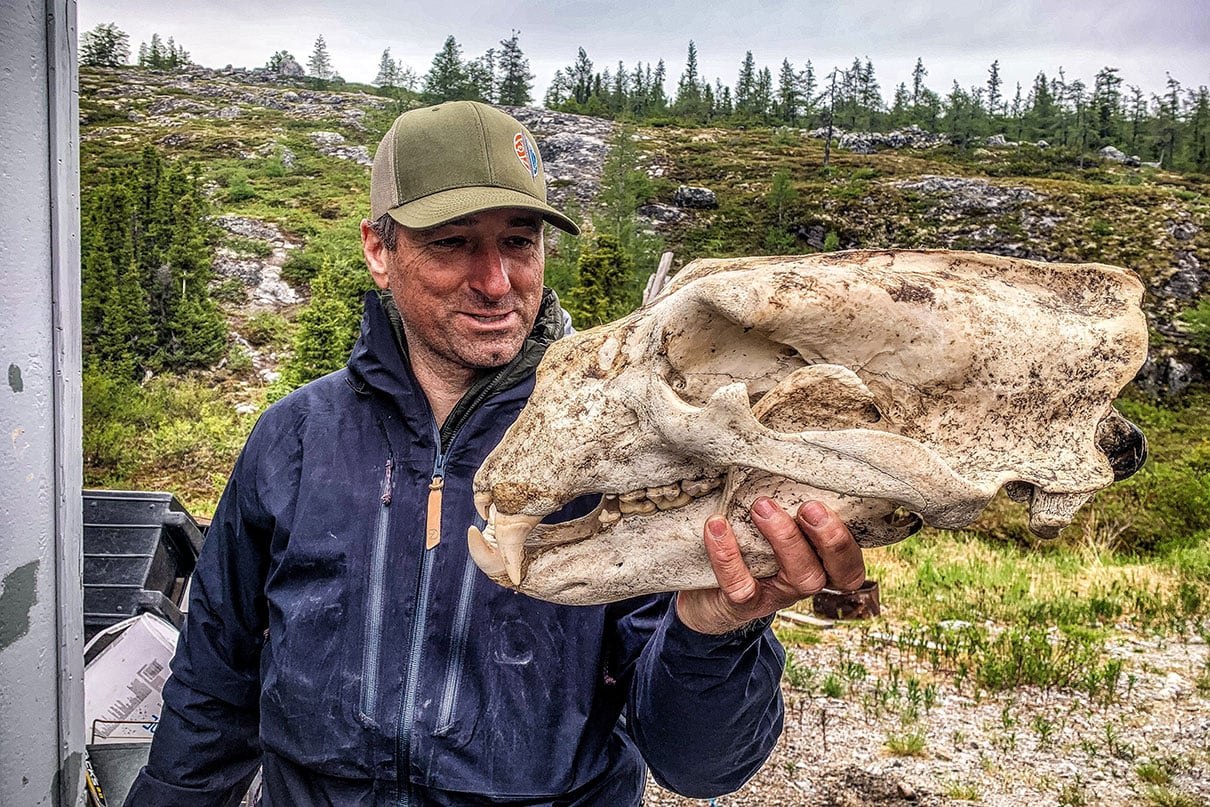
JF and I meet Larry Chomyn and Frank Wolf in Montreal in early June and fly north to Kuujjuaq, where we jam into a rickety 12-seater. Boxes, bags and a kid’s bike cram the tiny space between the friendly pilots and us. A roar of engines lifts us airborne, and I peer down at an endless plateau of bare grey rock dotted with pockets of scrubby green vegetation and thousands of lakes. An Inuit man in front of me plays Candy Crush on his phone until neat rows of colorful box-shaped houses appear below. We land in the isolated village of Kanjiqsujuak, Quebec’s northernmost settlement.
Polar bear watch
It is sunny the next morning, but the sea is nowhere to be seen. The tide tables say it will be back at 1 p.m. In Ungava Bay, the ocean rises and falls the height of a six-story building each day, disappearing up to 10 kilometers away. Sometimes patience is the better part of valor.
When water oozes under our fully loaded kayaks at noon, we take a team selfie before pushing off into frigid water. Butterflies are partying in my stomach at the unknowns ahead.
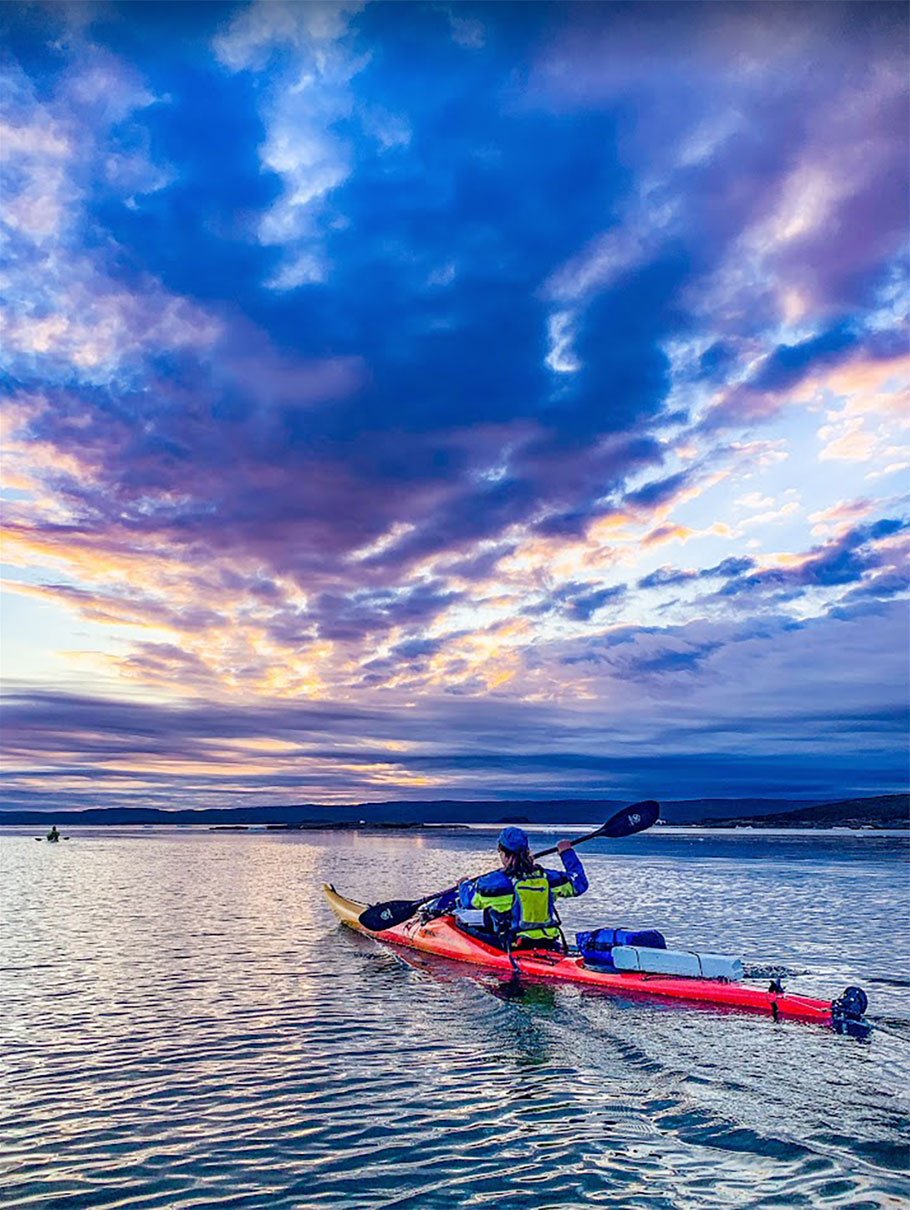
“How low is my kayak in the water?” Larry asks. Two large drybags are strapped onto his back deck, and I can barely see his seam. I hope the 15 oatmeal breakfasts in one of them will survive; there are no villages or resupply points for the next month.
Enthusiasm, excitement and pent-up energy power us forward against a brisk headwind and a steep, choppy sea. When the current turns against us, Larry and I cut close to the rocky shore while JF and Frank take the direct line across a bay. We don’t have a plan beyond moving north. It is our first trip together, and no one wants to impose their leadership.
Rocky vistas give way to vast muddy plains as the tide drops, forcing us to paddle farther from the glacier-smoothed hillocks of the treeless tundra. My paddle hits the bottom repeatedly, and it feels like the sea is racing to leave us stranded. We debate camp options while the wind blows us backward. Paddling toward what we think is a gravel beach proves to be a rock shelf fronted by a two-kilometer-wide boulder-strewn plain.
After scanning the map, we head to an island. Scrambling and slipping over wet boulders is the warm-up for a 400-meter leg-burning steep, rocky ramp. After seven round trips of gear hauling, we pitch camp by ancient stone circles at the flattish summit. Remote trips like this are hard work on and off the water. It’s not always fun, but I relish the unbeatable feeling of being physically and mentally spent. Now I have time to scan the rocky plateau stretching away as far as I can see. Tan lower slopes turn to carpets of black lichen above the high tide line.
That night, JF wakes me for watch. His nose is like an ice pack as he kisses my cheek. Shivering, I layer up and pull my neck buff up over my mouth. It is midnight; I have two hours on lookout.
A bright orange line along the horizon sits below layers of slate grey clouds. Our tent silhouettes are obvious, but I worry a bear could creep up on us. I sit on our one camp chair under a flapping tarp, shoulders hunched against the cold, two shotguns at my feet. One contains six shots of lethal ammo, and the other contains bear bangers. Grabbing a couple of lichen-crusted rocks to pound together, I complete my defense. I am surprised to find peace and enjoyment in the alone time.
A new rhythm
We shift our day to the tidal rhythm, rising at 2 a.m. to launch nearer to high water. As the water level drops throughout the day, reefs force us ever outward, and we go around islands rather than risk dead ends.
After a week, a barely rippled sea under a pink sky dotted with cotton wool clouds welcomes the new day. We should make quick progress, but ice floes are common and photos slow us. Promising myself I am done with photos, another glinting, sculpted iceberg appears. We are approaching the northeast tip of continental Canada and drawing nearer to the broken-up ice pack. Onshore gusts are like opening the freezer door, cold air rushing through me. I wiggle my numb toes constantly and regret not bringing more warm clothes. A harp seal pops up its round, grey head behind JF, reminding us this is prime polar bear habitat. Small bergs look just like bear heads and we study them carefully.
Steep, rugged mountains line both sides of the breathtakingly beautiful McLellan Strait, which leads to the east coast. The following day, we approach the ice-choked narrow channel with anticipation, knowing the currents fly through at up to eight knots. Progress is almost impossible. Icebergs of all shapes and sizes fly toward us, and continuing would be like cycling the wrong way up a motorway. Pulling our kayaks up a rocky beach to wait out the tide, we explore a wide terrace.
Farther back is a bottle-shaped depression hewn from the ground. I gasp, recognizing the outline of an ancient sod house—an Inuit shelter. Walking gently inside, the remains of earthen walls reach up to my waist, their musty smell filling my nostrils. Reaching out, I can almost touch all three sides. I marvel at how people survived and thrived in such a small space in such a harsh world.
Some of our friends think we are brave for paddling in this cold, windy, polar bear-ridden land, but we are merely passing through with all our food, warm clothes and technology. The Inuit quietly lived here for centuries, taking gifts of land and sea when offered, hunkering down and eking out in times of scarcity. I aspire to such wisdom in my more contrived wilderness experiences and struggles.
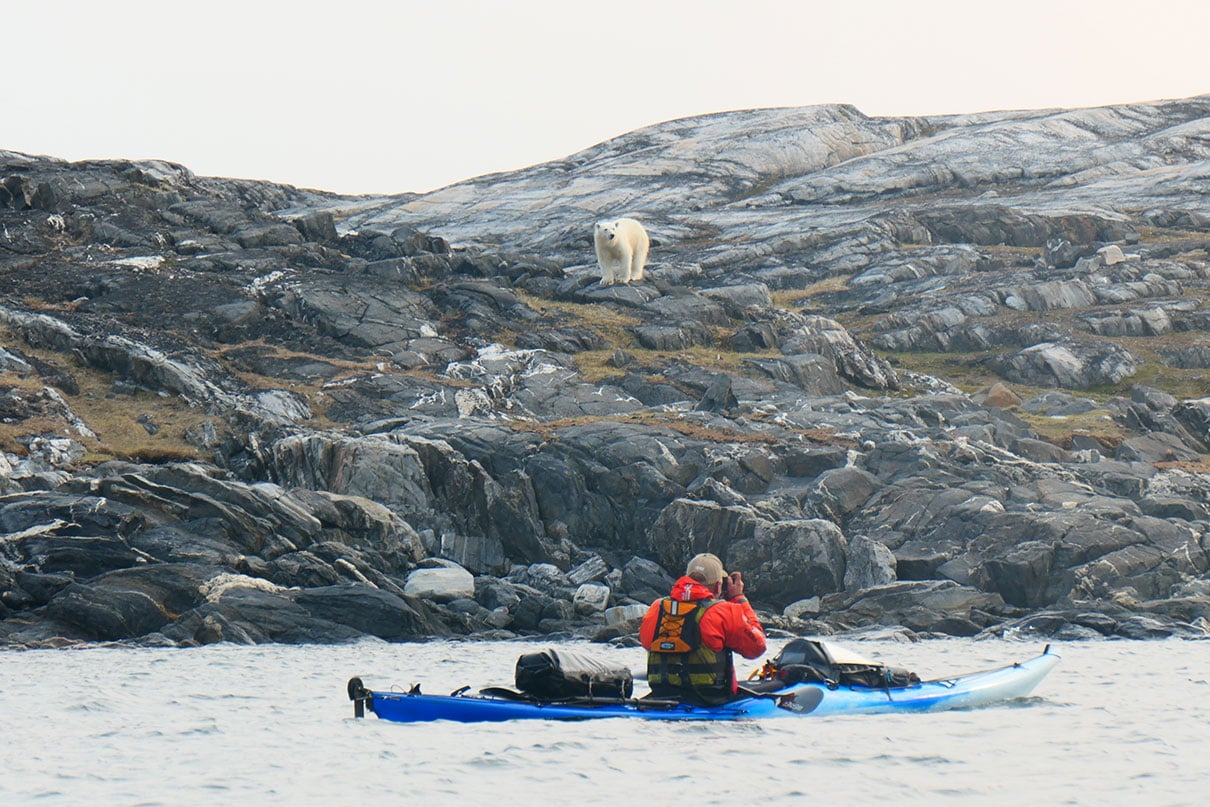
Place of the spirits
We see our first bear the next morning. Larry points to Almaty Island, a few hundred meters away. The bear is sauntering purposefully over the rock, oblivious to us. I am struck by its size and majesty. Frank paddles in for a closer look. I follow behind, drawn magnetically to the powerful predator. About 100 meters away, we stop. What long leg fur, I think, like hairy flares. Finally, the bear sees us and turns, his nose held high and tongue out to taste us. He is imposing.
“It’s a male, probably four or five years old,” Frank shares. He pulls out his phone and enters the details on a bear tracking app he contributes to.
We see bears almost every other day after that. The next one is way high up on a ridge. It turns onto its belly to slide down a snow patch like a kid. I giggle. He moves on and disappears from view. We paddle around a corner looking for him, and a small ice floe catches my eye. It doesn’t move. Two black eyes and a shiny black nose give him away. A few days later, approaching a fjord called Bear Gut, another polar bear swims toward us, lifting his nose high to smell us.
After we pass him, I stop to film, and the bear swims around behind me, a few boat lengths away. As I concentrate on keeping my camera steady, he drops his head under the water and disappears. I hear Frank say, “aquatic stalking,” and I strongly sense I don’t want to find out what that means first-hand. I curse my slowly retracting camera lens before thrusting my paddle deep and pulling as hard as I can. We don’t see the bear again.
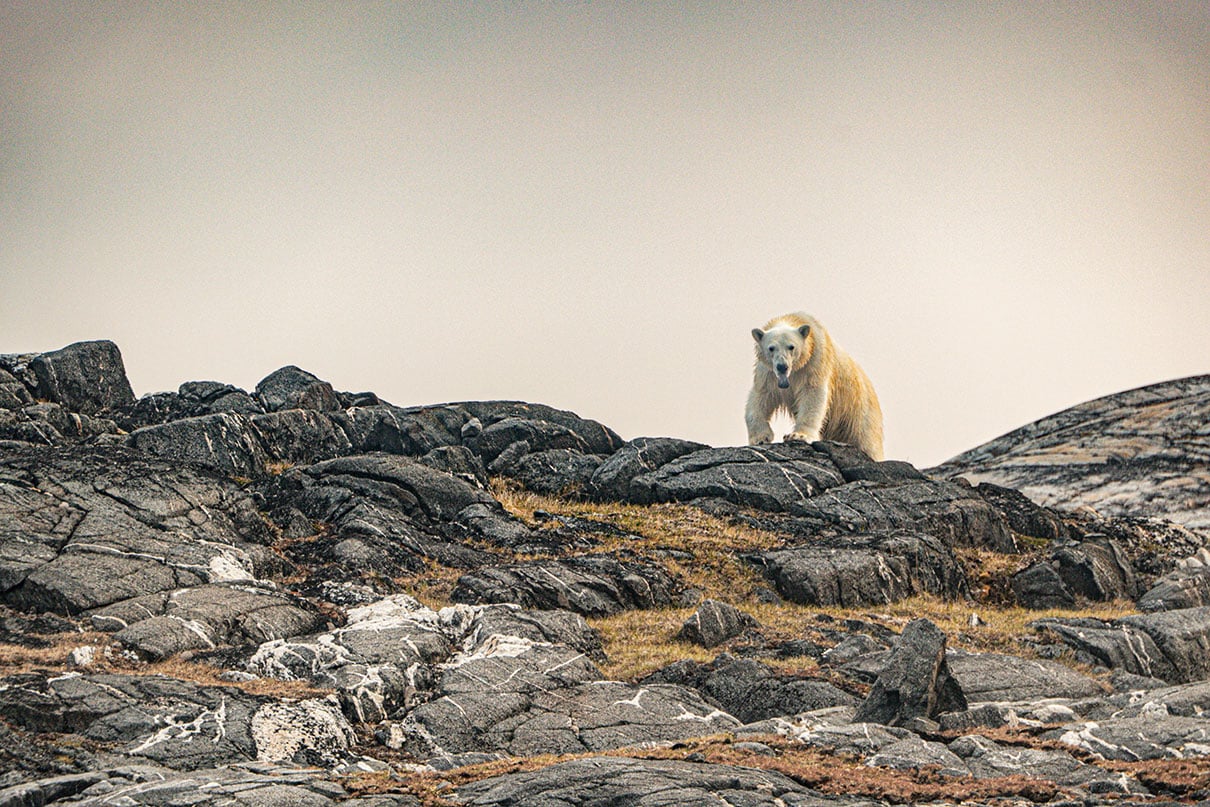
The Torngats take their name from the Inuktitut word Tongait, meaning place of the spirits. I feel reverent amongst the steep, towering peaks that reach skyward, connected to the ancient energy. Sharp flanks and sinuous ridgelines are exposed, giving a rawness to these ancient rock piles. Every imperfection is laid bare like we’re seeing the skeleton of the Earth herself.
Land of the white bear
We are three-quarters of the way through our trip when the polar bear sneaks up on me. I have become complacent, focusing too much on diary writing and not looking around often enough. By the time I leap from my chair, the bear is two meters from me. The flare gun is at my feet, within reach, but I dare not look down to get it. Taking my focus off this bear could be my last mistake. Instead, I shout, “Go away! Go away! Go away!” The bear stops, his eyes locked on mine.
My brain whirrs. Can I grab the flare gun without looking down? Can I use the fire behind me? The two shotguns are five meters away—too far. There’s no time to regret my lack of preparation. I am strangely aware of the beauty and closeness of this magnificent creature while fearing for my life. I shout continuously: “Go away! Go away!”
The bear takes a slow step toward me. Instinct takes over, and I grab the nearest object—the lightweight camp chair I was sitting on. Holding one metal leg, I thrust toward the bear, swinging it wildly. “Go away! Go away!”
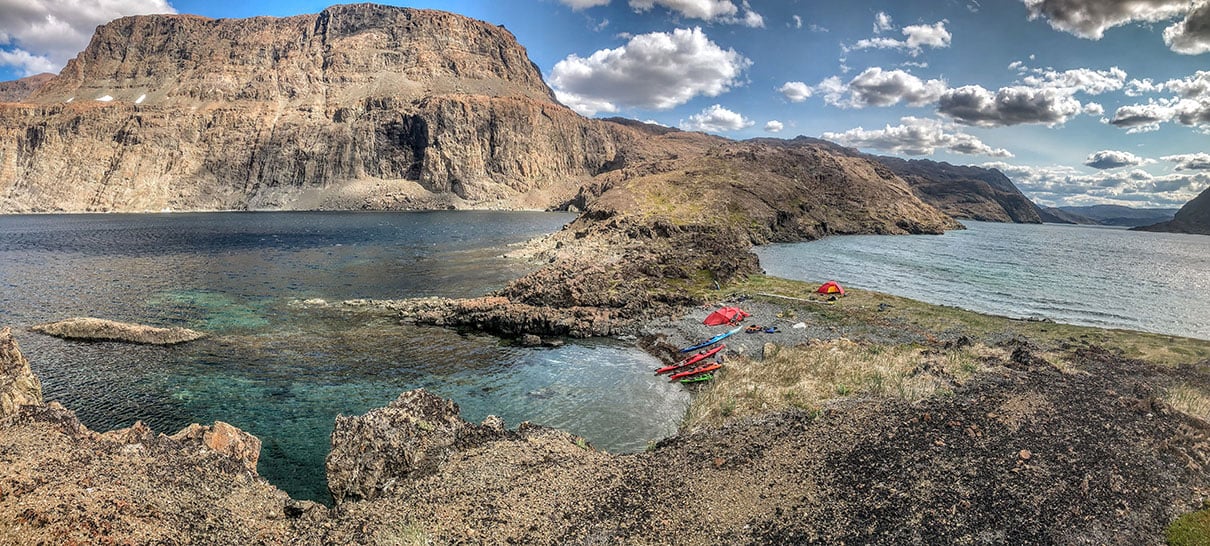
The bear lunges backward, moving his head away from impact. Even with the seriousness of the situation, it’s almost funny such a huge, powerful creature is scared of a one-pound chair. Still, I’m merely buying time. I’m desperately searching for my next move when a loud bang rings through the air. I later find out it’s Larry, quick to get out of the tent and fire a warning shot. The bear turns and bolts, knocking over the tripod of paddles holding our water filter. Relief floods me, and I lower my eyes and grab the flare gun.
Holding one metal leg, I thrust toward the bear, swinging it wildly. “Go away! Go away!”
As I look up, I see the bear halt, turn around and start back toward me. I point the flare gun at him. He’s five meters away but not paying me any attention this time. He starts sniffing the paddles. There’s another bang, and the bear bounds away 30 meters. I fire my flare just above his head, hoping to reinforce the warning, but it only seems to remind him of unfinished business. Before the flare even hits the ground, the bear stops, turning back around, eyes locked on me again. Head down, accelerating in my direction.
I spin around, desperately searching for another flare or another gun. I see JF behind me with a shotgun. Out of the corner of my eye, I see a blur of white and whip around. The bear has changed tack; he’s off to my side and charging at Larry and Frank, who are standing by their tent. My heart lurches. Frank doesn’t have a gun and runs behind the tent. The bear is a leap away from our teammates. Larry holds his ground and fires a bear banger with a loud crack. Stopping at the last possible moment, the bear U-turns rapidly and charges away over the tundra.
This time, he doesn’t come back.
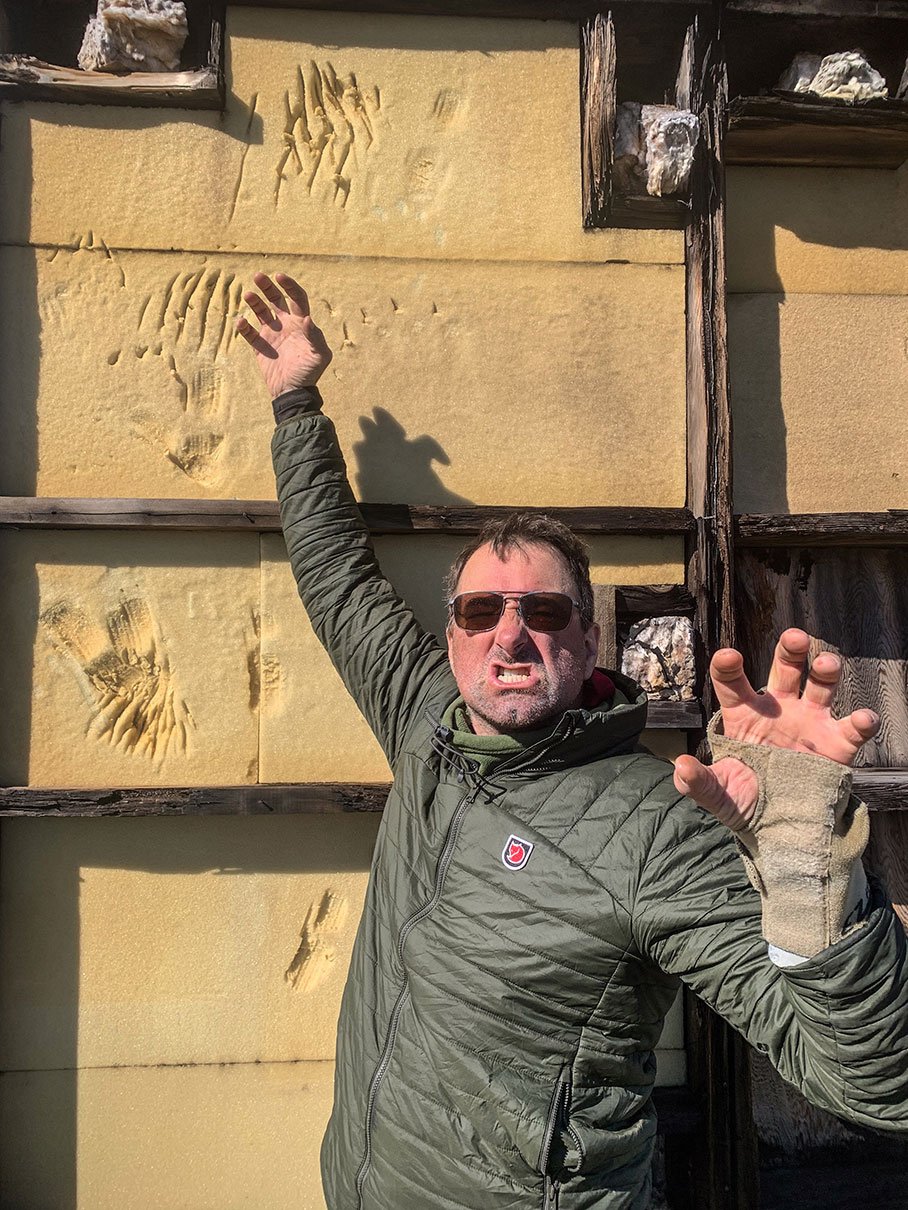
After checking in with each other and ensuring the bear has gone, the others return to bed, and I am left alone again by the fire to finish my watch. Heavy feelings swirl with adrenaline: relief, excitement, guilt and resolve.
A few mornings later, we discuss the close call. There are many lessons. As the trip wore on without incident, our tents got too far from each other and we didn’t put our fence around them, expecting the person on watch to see a bear.
From now on, we will put the tents closer together and always use the bear fence. Each tent will have a gun, and we will be on high alert at all times. I’m happy everyone walked away from the incident, but I can’t shake a dull ache in my stomach, a heavy guilt that my inattention risked everyone’s lives, including the bear’s.
As we draw closer to our endpoint in Nain, everything feels tamer. In the Okak Islands, JF excitedly shouts “trees” and points at a few pockets of stunted conifers. Later, valleys are covered in lush green grass and bushes. It gets warmer; I no longer need a hot water bottle during night watch. I wander around in my thermals to dry them, realizing thin merino is no match for the probing proboscis of the suddenly plentiful mosquitos. The hardiest follow us hundreds of meters out to sea.
Cruising beside cliffs, the sleek black back of a minke whale emerges; the graceful arc of the fin is gone as quickly as it appeared. We see more black bears than polar bears, sometimes three in a day, their dishevelled fur highlighted by the sun. I notice how tiny they look in comparison.
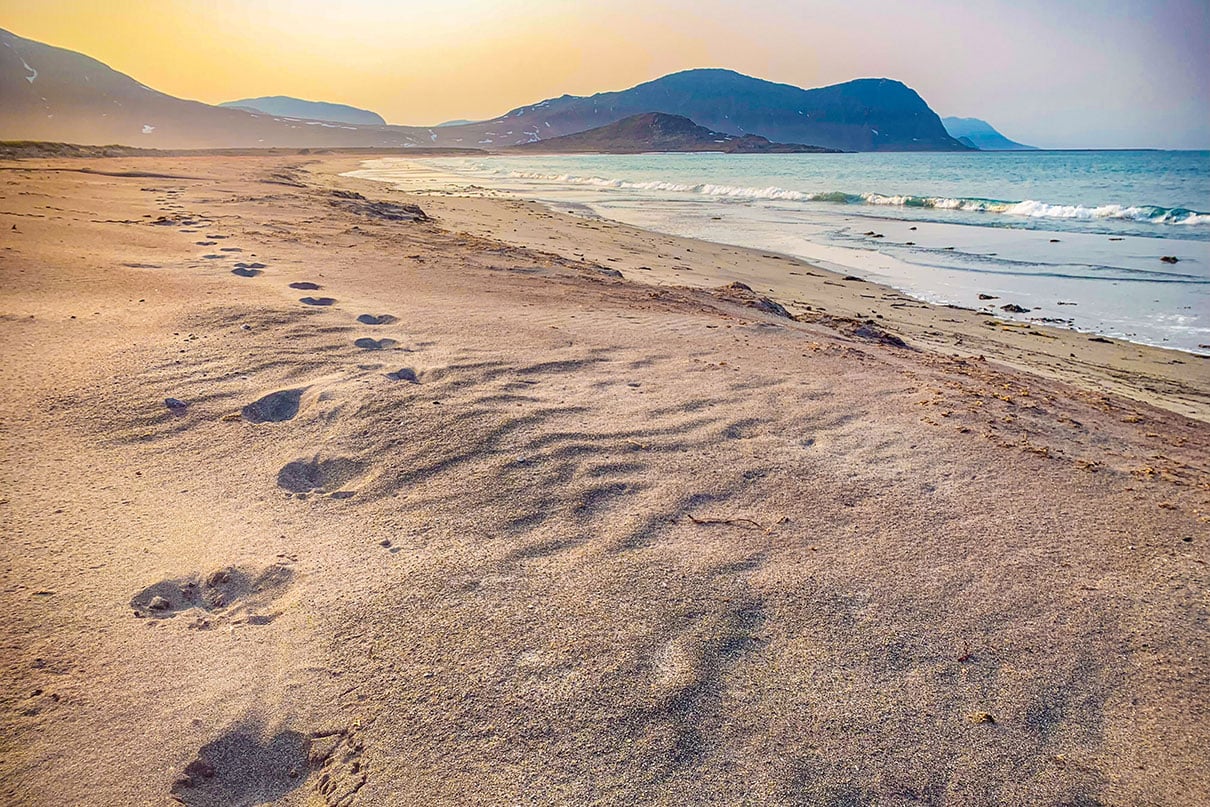
After 28 days, we start our last five-kilometer crossing to Nain on glassy seas. After so long with only the wind and waves, the piercing buzz of a helicopter jars my ears. It’s strange to be back in the bustle of even a small community. In four weeks, we’ve seen 10 polar bears, 14 black bears, dozens of caribou, a walrus and just five people. There aren’t many places in the world so isolated.
JF’s definition of a good adventure is one where we’re part of the food chain, and this one surely qualifies. I just hope never again to be quite so close to being the dish of the day.
Justine Curgenven is an award-winning filmmaker, a sea kayak guide, and a lover of wilderness and laughter. Her ambitious expeditions have placed her among the world’s most legendary paddlers. Find her online at cackletv.com.
A polar bear tastes the air when he sees us, trying to get our scent. | Feature photo: Frank Wolf



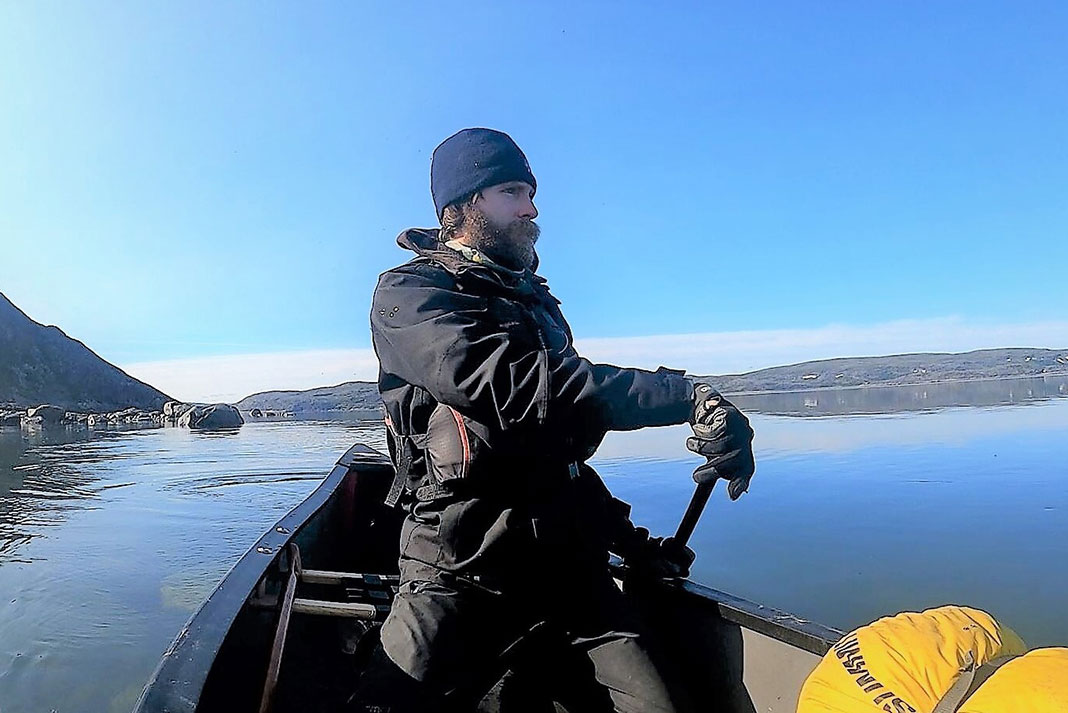
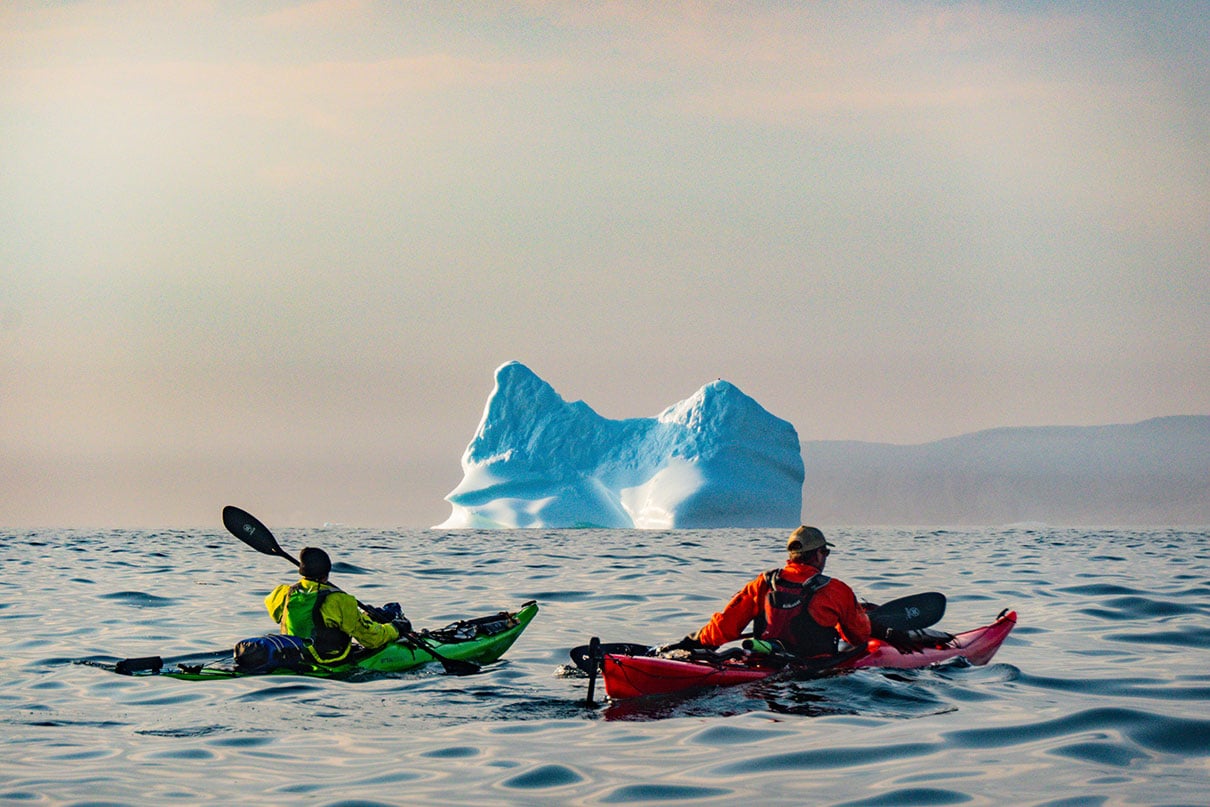
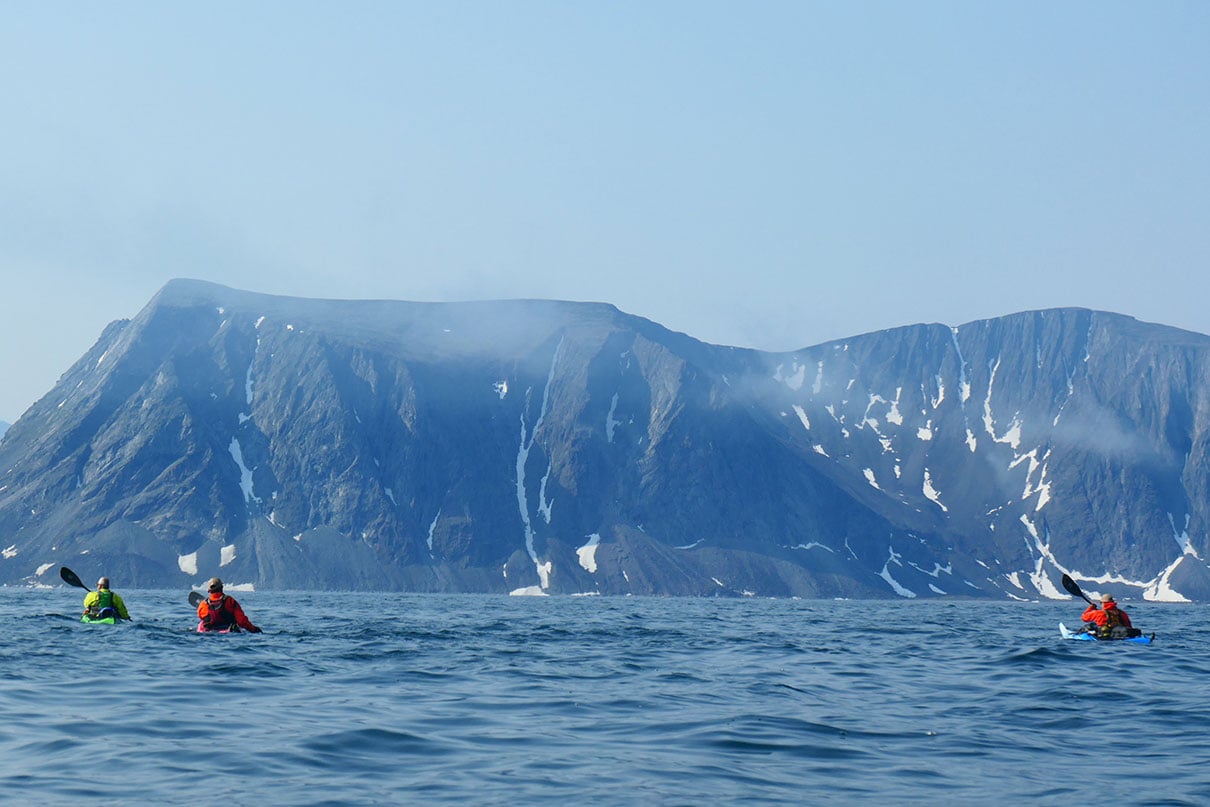
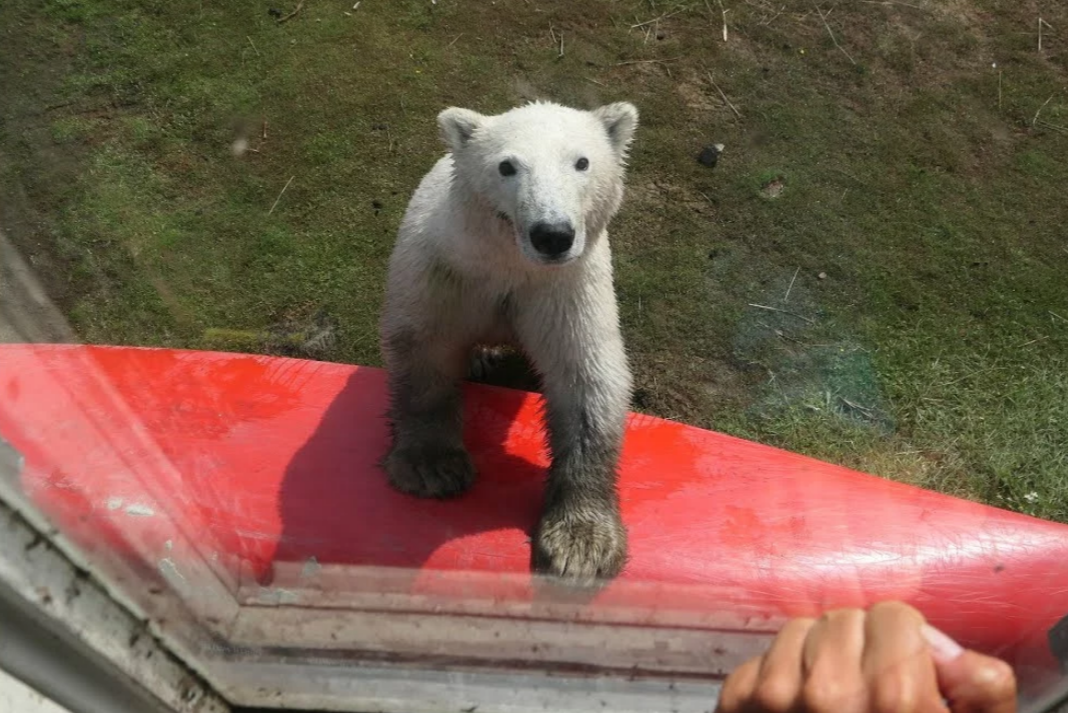
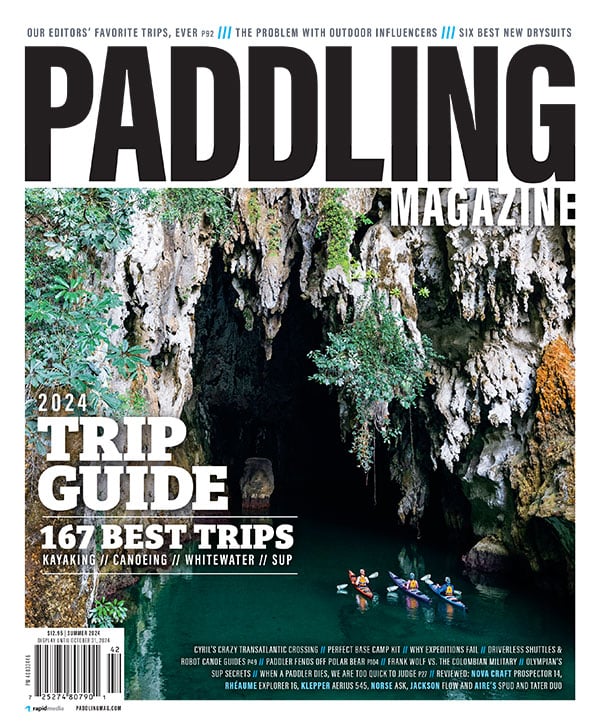 This article was first published in Issue 72 of Paddling Magazine.
This article was first published in Issue 72 of Paddling Magazine. 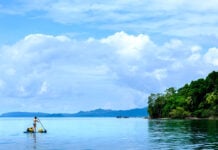
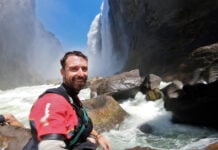
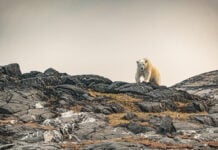
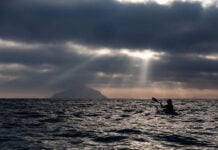
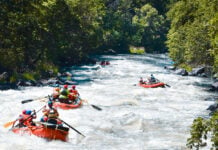

Breathtaking.
I will read anything Justine Curgenven writes. Ever.